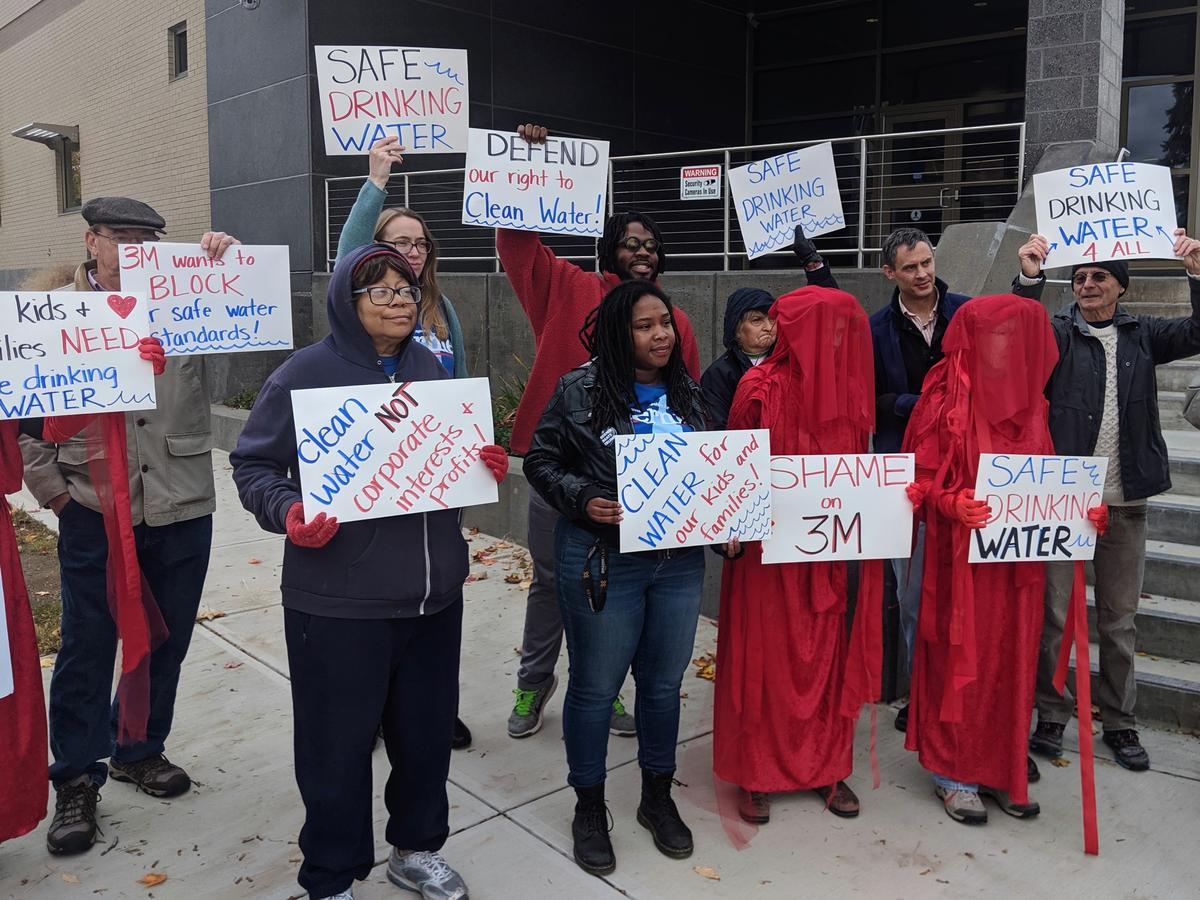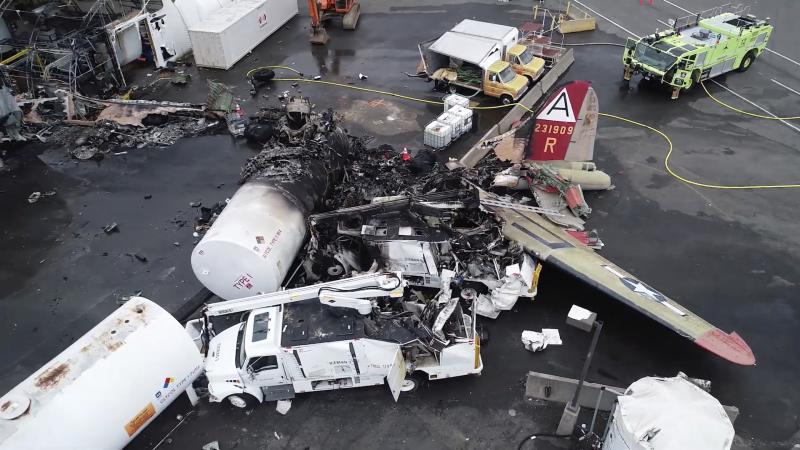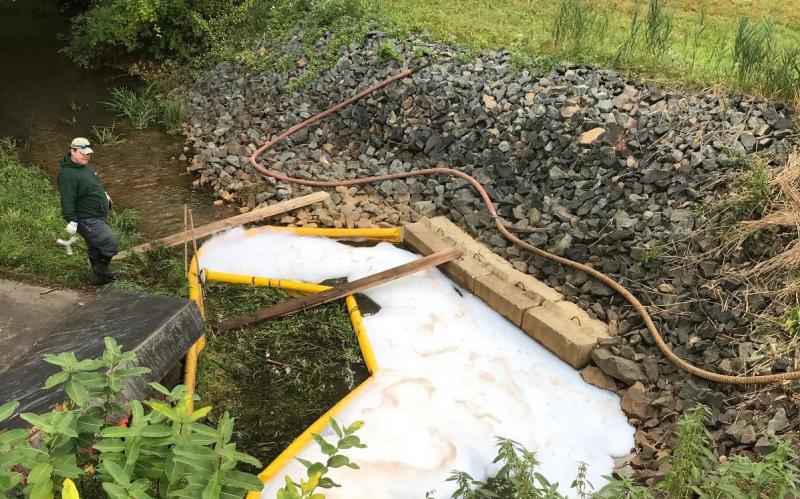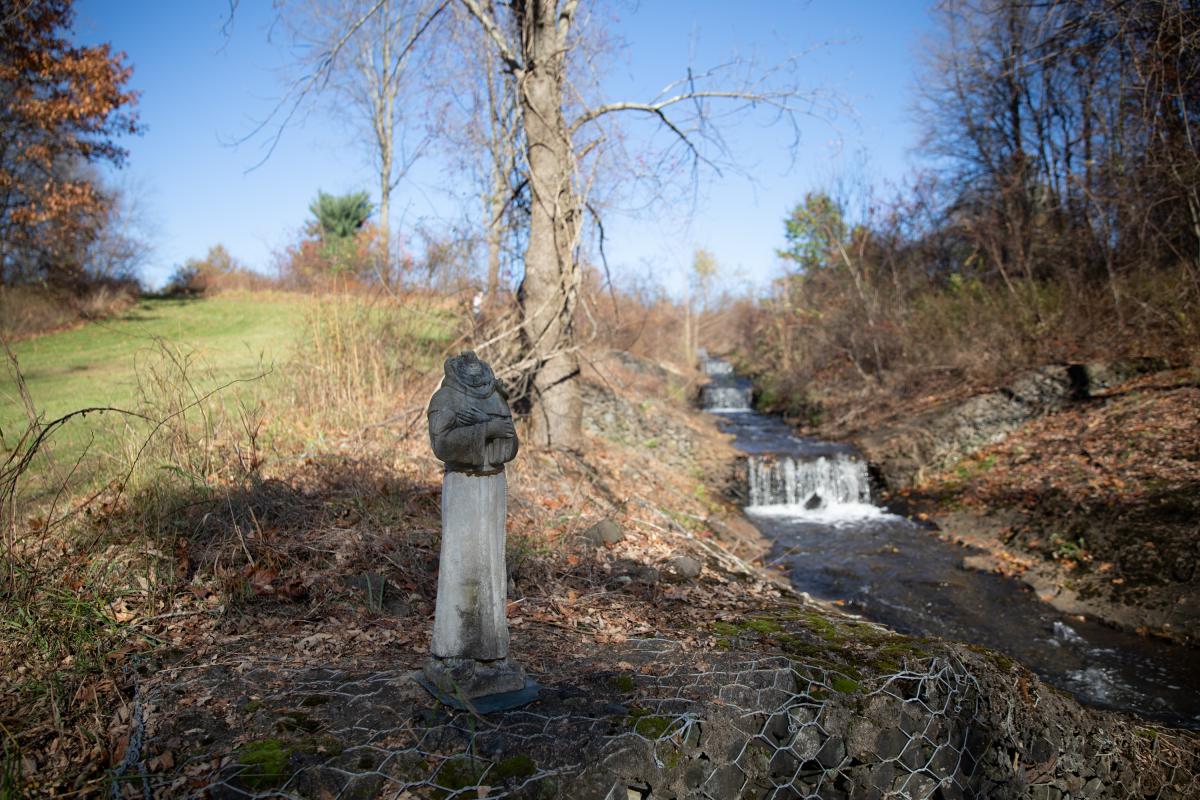Episode 174: PFAS And The Ethics Of Contamination; Thanksgiving Misconceptions
PFAS chemicals have contaminated sites around New England, but when a World War II-era bomber crashed at Bradley International Airport in Connecticut last month, firefighters did not hesitate to use foam containing the chemicals. This week on NEXT, we’ll talk about the ethical balance between saving lives in the moment and long-term health risks. And with Thanksgiving coming this Thursday, we’ll look at what we get wrong about Thanksgiving history (here’s a hint, they’re not called Pilgrims). Plus, the case for living in a cohousing community.

PFAS-filled Aqueous Film Forming Foam in the brook behind Paddy Abramowicz’s home in Windsor, Connecticut. (Credit Paddy Abramowicz)
Debate Over Science and Risks Shapes 3M’s Lawsuit Against N.H.’s PFAS Water Standards

Drinking water advocates protested in Concord, New Hampshire before a court hearing with 3M and the state earlier this fall. Some protesters wore red cloaks in support of the Extinction Rebellion movement. (Annie Ropeik/NHPR)
The full name of a class of chemicals known as PFAS is as hard to pronounce as it is to understand: per- and polyfluoroalkyl substances. These “forever chemicals” persist in our bodies and the environment, and they’re in products we use all the time – from pizza-boxes to non-stick cookware to raincoats.
This fall, New Hampshire’s strict new limits on PFAS chemicals in drinking water went into effect. But now, the state is being sued over those limits. The lawsuit is spearheaded by 3M, the chemical company that helped invent PFAS. Their partners in New Hampshire include a cattle farmer, a fertilizer company and a town water utility. Hear about the state’s regulations and the case building against it.
Update: This week a judge ruled that New Hampshire would have to stop implementing its strict PFAS limits on December 31. The judge’s ruling did not take immediate effect, giving all parties time to appeal the decision with the state supreme court.
Connecticut Plane Crash Highlights Toxicity Fears Over Firefighting Foam

This image taken from video provided by the National Transportation Safety Board shows damage from a World War II-era B-17 bomber that crashed at Bradley International Airport on Oct. 2. (National Transportation Safety Board via AP)
When a World War II-era bomber crashed and caught fire on a runway at Bradley International Airport in Connecticut last month, killing 7, first responders fought the blaze with a special type of firefighting foam. The foam is required by the Federal Aviation Administration for its effectiveness against fuel fires. But at the same time, the Environmental Protection Agency says there’s emerging evidence some of the chemicals found in those foams are toxic to humans and the environment. Learn how the vintage bomber crash is highlighting the conflicting messages of both agencies and the confusion for airports and communities caught in the middle.
PFAS In Your Backyard
- An area set up to contain PFAS-filled foam after the crash of a B-17 at Bradley International Airport. (Connecticut Department of Energy and Environmental Protection)
- PFAS-filled Aqueous Film Forming Foam in the brook behind Paddy Abramowicz’s home in Windsor. (Credit Paddy Abramowicz)
- The brook behind Patty Abramowicz’s house in Windsor, on Nov. 2, after the foam was removed. (Patrick Skahill/Connecticut Public Radio)
After the B-17 plane crashed at Bradley, some of the PFAS in the firefighting foam washed out of the airport and into nearby communities. Paddy Abramowicz, who lives a five-minute drive from the airport, says a few days after the crash, she was walking by the brook in her backyard. On the water, she saw piles of firefighting foam more than 10 feet high.
Listen to our interview with David Resnik, a bioethicist at the National Institutes of Health, where we talk about the best way to balance the needs of those in immediate danger against potential long-term risks to the environment and human health?
PFAS sites in New England by state and military bases:
Note: some state information is more detailed than others.
Seeking Support, Homeless Maine Teens Are Often Forced To Leave Their Communities

“My anxiety, my depression, everything came out as anger. I looked at the world as a hateful, hateful place. Once my friends started dying and stuff, I just thought the world was a hateful place,” says Avory, who was moved around the state from Penobscot County to Portland. “I’ve always looked at the world as a hateful place until I came to New Beginnings.” (Robbie Feinberg/Maine Public)
Because of funding cuts, programs and youth homeless shelters have closed in several small communities. With fewer resources, teens in rural areas have had to face a tough choice: stay within the community they know or move to an unfamiliar city that might offer more support. We have the story of teens who made that challenging decision.
Our Thanksgiving Misconceptions

(vxla/Flickr)
There are some things we claim to know about Thanksgiving and the arrival of the Pilgrims that are correct: the white settlers and Native Americans really did get along together, they had a feast and played games. But there are many facts we get completely wrong. For one, the Pilgrims were not called Pilgrims when they arrived. And sociologist James Loewen, author of Lies My Teacher Told Me: Everything Your American History Textbook Got Wrong, says they were not coming to the Americas for religious freedom. Hear what else people get wrong.
What else you’ll hear on Episode 174:
- The case for cohousing
- The millions of tons of plastic that disappear in our oceans
- The spacious eerie music of a New England cellist
About NEXT
NEXT is produced at Connecticut Public Radio
Host: Patrick Skahill
Producer: Morgan Springer
Digital Producer: Carlos Mejia
Senior Director: Catie Talarski
Contributors to this episode: Annie Ropeik, David Resnik, Ben Brock Johnson, Robbie Feinberg, Liam Elder-Connors and James Loewen.
Music: Todd Merrell, “New England” by Goodnight Blue Moon, “The Hollow” by The Wolff Sisters, “Golden Hands” and “To Meet You There” by Anjimile and “So Blue” by Audio Jane.


